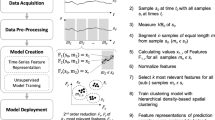Abstract
Today’s advanced complex manufacturing processes from microelectronics to pharmaceutical industries provide huge datasets (big data) from heterogeneous multi-sensory monitoring. Analytical tools for such high-dimensional and large datasets are available to support manufacturers in quality and yield optimization, but latent problems efficiently linking process data to these tools exist, the available methods are not fully satisfactory, and the real-time support is very limited. In this work, one particular industrial process from polymer industry was investigated as a research vehicle for the development of methods for efficient process interfacing, process status classification and prediction, as well as online result visualization. Novelty filtering, anomaly detection, and one-class classification (OCC) methods have been in the focus of the investigation. These methods are of particular importance as expert knowledge from the production lines discloses that the process shows unexpected states and behavior during production runs, which lead to low yield and high cost. Causes for this abnormal behavior are assumed sensor faults, environmental influences, and unexpected raw material properties’ deviations. Thus, novelty filters, anomaly detection, and OCC methods are particularly suitable for such cases. A process line from standard production with approximately 160 sensory channels has been monitored for 3 months in 1-min intervals. This provided 21,900 process data mostly normal condition samples of about 160 dimensions each for the conducted experiments. Accuracies of 99 % in OCC were achieved, and a first prototype of an advanced novelty detection GUI for process monitoring was conceived, which supports the process monitoring by the responsible staff. The achieved results allow predicting process yield problems within 2 h in advance of occurrence despite unknown objects. Future work will focus on exploiting this for advanced process control and yield optimization.





Similar content being viewed by others
References
de Ridder D, Tax D, Duin R (1998) An experimental comparison of one-class classification methods. In: Proceedings of the 4th annual conference of the advanced school for computing and imaging
Martin W (2008) Trends in data mining. BeyeNETWORK. http://www.beyenetwork.de/view/8192. Accessed 28 Feb 2014
Steinwart I, Hush D, Scovel C (2005) A classification framework for anomaly detection. J Mach Learn Res, MIT Press, MIT University, 211–232
Tax D (2001) One-class classification: concept-learning in the absence of counterexamples. Doctoral Dissertation, University of Delft, The Netherlands
Khan S, Madden MG (2010) A survey of recent trends in one class classification. Artif Intell Cognit Sci Lect Notes Comput Sci 6206:188–197
Smets K, Vreeken J (2011) The odd one out: Identifying and characterising anomalies. In: Proceedings of the 11th SIAM international conference on data mining (SDM), Mesa, AZ, pp 804–815
Bartkowiak A (2010) Anomaly, novelty, one-class classification: a short introduction. In: Proceedings of computer information systems and industrial management applications 1–6 IEEE Xplore. doi:10.1109/CISIM.2010.5643699
König A, Raschhofer RJ, Glesner M (1994) A novel method for the design of radial-basis-function-networks and its implication for knowledge extraction IEEE world congress on computational intelligence. doi:10.1109/ICNN.1994.374430
König A, Windirsch P, Gasteier M, Glesner M (1995) Visual inspection in industrial manufacturing. IEEE Micro 15:26–31
König A, Gratz A (2005) Advanced methods for the analysis of semiconductor manufacturing process data. In: Pal NR, Jain LC (eds) Advanced techniques in knowledge discovery and data mining. Springer, Berlin, pp 27–74
Gneuss Kunststofftechnik GmbH. http://www.gneuss.de/. Accessed 28 Feb 2014
Hodge V, Austin J (2004) A survey of outlier detection methodologies. Artif Intell Rev 22(2):85–126
Shin HJ, Eom D-W, Kim S-S (2005) One-class support vector machines: an application in machine fault detection and classification. Comput Ind Eng 48(2):395–408
Kohlert M, König A (2012) Advanced polymeric film production data analysis and process optimization by clustering and classification methods. In: KES, pp 1953–1961
Moyne J, Del Castillo E, Hurwitz A (2001) Run to run control in semiconductor manufacturing. CRC Press, Boca Raton, FL
König A (2001) Dimensionality reduction techniques for interactive visualisation, exploratory data analysis and classification. In: Pal NR (ed) Pattern recognition in soft computing paradigm. World Scientific, FLSI Soft Computing Series, vol. 2, ISBN 981-02-4491-6, pp 1–37
Sun D, Tran Q, Duan H, Zhang G (2005) A novel method for Chinese spam detection based on one-class support vector machine. J Inf Comput Sci 2(1):109–114
Tax DMJ, Duin RPW (2004) Support vector data description. Mach Learn 54:45–66
Duin RPW, et al (2007) A matlab toolbox for pattern recognition. PRTools. http://prtools.org/. Accessed 28 Feb 2014
Tax DMJ (2013) Data description toolbox. Pattern Recognition Laboratory. http://prlab.tudelft.nl/david-tax/dd_tools.html. Accessed 28 Feb 2014
König A, Glesner M (1992) VLSI implementation of associative memory systems for neural information processing. In: Proceedings of the third Int’l Workshop on VLS/for neural networks and artificial intelligence
The MathWorks Inc. http://www.mathworks.de/. Accessed 28 Feb 2014
Author information
Authors and Affiliations
Corresponding author
Rights and permissions
About this article
Cite this article
Kohlert, M., König, A. Large, high-dimensional, heterogeneous multi-sensor data analysis approach for process yield optimization in polymer film industry. Neural Comput & Applic 26, 581–588 (2015). https://doi.org/10.1007/s00521-014-1654-5
Received:
Accepted:
Published:
Issue Date:
DOI: https://doi.org/10.1007/s00521-014-1654-5




